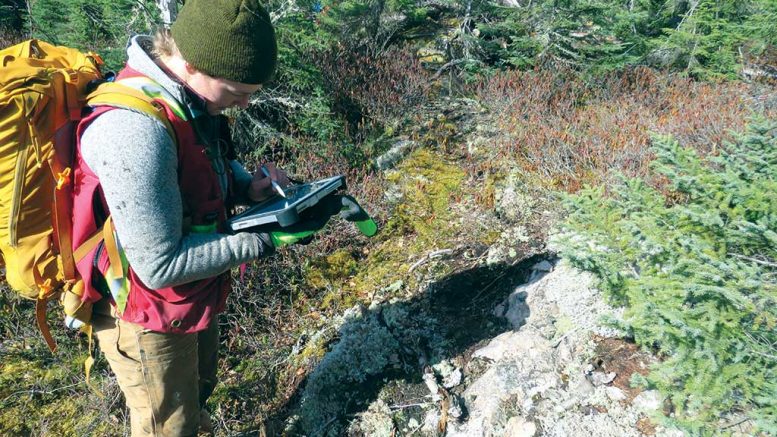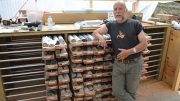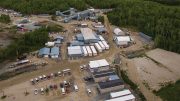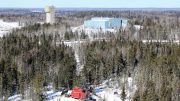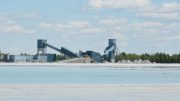While Ontario remains the largest mineral producer in Canada, there remains a lively junior exploration and development scene across a wide variety of targets including gold, silver, cobalt and diamonds. The following is a look at seven junior mining companies active across the province.
BRIXTON METALS
Vancouver-headquartered Brixton Metals (TSXV: BBB; US-OTC: BXTMF) is an exploration and development company focused on advancing its wholly owned gold and silver projects, which include four substantial properties: the past-producing Langis and Hudson Bay silver-cobalt mines in Ontario’s historic Cobalt camp; the advanced stage Hog Heaven polymetallic project in Montana; the district-scale Thorn gold-silver-copper project in B.C.; and the early-stage Atlin gold project in northwestern British Columbia.

Drillers at the Thorn polymetallic project, 130 km southeast of Atlin, British Columbia. Credit: Brixton Metals
Brixton’s work at Langis took an unexpected turn in August with the discovery of significant kimberlite intercepts and a small, clear diamond fragment in core while targeting cobalt-nickel-silver mineralization in shallow Archean rocks.
“We are very intrigued by this discovery,” Brixton chairman and CEO Gary R. Thompson stated. “The fact that we recovered a diamond fragment given that the kimberlite sample size was very small is an exciting discovery. The kimberlite in hole 36 to hole 37 is 149 metres apart, and the distance of the kimberlite from hole 37 to the kimberlite in hole 34 is 515 metres. This has piqued our interest as to whether a very large kimberlite pipe or a series of pipes exists.”
As late as July, Brixton had been looking to spin out its cobalt assets to focus on precious metals, but this subsequent diamond discovery may have paused this strategy for now.
CRYSTAL LAKE MINING
Vancouver-based junior Crystal Lake Mining (TSXV: CLM; US-OTC: SIOCF) is looking to advance its Nicobat nickel-cobalt project near Emo in northwestern Ontario, 35 km from New Gold’s Rainy River mine.
To that end, Crystal Lake closed a $1-million financing in May 2018, with each unit of the private placement consisting of a share and one full warrant that allows the holder to buy another share at 70¢ within two years.
Crystal Lake says the project has several highlights: the historic mineral zone Nico1 has yet to be tested at depth; the nickel “tenor” (metal content in 100% sulphide) is estimated at between 3% and 4%; Crystal Lake’s last drill hole in late 2015 cut high-grade nickel-copper; it is an “ideal geological setting” for a nickel-copper-cobalt-platinum-palladium massive sulphide discovery in an under-explored region; the overall land package is “highly prospective with multiple target areas”; and there is “excellent infrastructure,” with roads, rail and power all present.
The company says it is well-positioned through Emerald Lake, its geological contractor, to undertake a program this year using a team of explorers from Ronacher McKenzie Geoscience Inc., backed by the magmatic sulphide expertise of Lightfoot Geoscience.
EDISON COBALT
Edison Cobalt (TSXV: EDDY; US-OTC: PWMRF) is the new name for Vancouver-based Power Americas Minerals, which is focused on the procurement, exploration, and development of cobalt and other energy metals in North and South America.
Edison Cobalt’s flagship is the Kittson cobalt project near the town of Cobalt, Ont., and hosts the historic Thomas Edison, Shakt-Davis and Cobalt-Kittson mines, as well as numerous historic workings, the deepest extending down to 191 metres, and over 762 metres of lateral workings.
The Thomas Edison mine was developed by the eponymous American inventor and entrepreneur.
Edison Cobalt describes cobalt mineralization as occurring in Proterozoic-aged, quartz-carbonate veins hosted in brittle shears in Nipissing diabase, with this style of mineralization being similar to that of the famed Cobalt Silver Camp located 15 km east of the property.
The junior says historic reports from the Shakt-Davis mine indicate values of 1.5% cobalt over 1.37 metres and grab samples returning up to 4% cobalt and 93.3 grams gold per tonne. Locally significant nickel, copper, and to a lesser extent, lead, zinc and bismuth also occur within the quartz-carbonate veins.
FIRST COBALT
Trent Mell-led First Cobalt (TSXV: FCC; US-OTC: FTSSF) describes itself as the largest cobalt exploration company in the world, and aims to create the world’s “largest pure-play cobalt exploration and development company.”
Only a year and a half old, First Cobalt has already accumulated over 100 sq. km of prospective ground in Ontario’s iconic Cobalt camp, with the company’s Greater Cobalt project comprising land that includes over 50 past-producing mines, a mill and the only permitted cobalt refinery in North America that makes battery materials.

A driller on a rig at First Cobalt’s project near Cobalt, Ontario. Credit: First Cobalt.
In June, First Cobalt outlined a $9-million work program for its new Iron Creek cobalt-copper project in Idaho, where it intends to calculate a resource estimate by October 2018, and complete another 30,000 metres of drilling to double the mineralized zone along strike beyond the area drilled in 2017.
The historic resource at Iron Creek is 1.2 million tonnes grading 0.59% cobalt.
In early September, First Cobalt acquired 100% ownership of the Iron Creek property and eliminated an outstanding royalty.
The company says it has begun a consultation process at Iron Creek and started collecting baseline data for future permitting.
GREAT BEAR RESOURCES
Chris Taylor-led gold junior Great Bear Resources (TSXV: GBR; US-OTC: GTBDF) — part of Vancouver’s Discovery Group of companies — closed out August by lining up a potential $10-million private placement, highlighted by gold mining executive Rob McEwen personally investing $4.8 million, and McEwen Mining chipping in $1.2 million of the total.
The placement will be priced at $1.45 per unit, with each unit to consist of a share and half a warrant, with each whole warrant exercisable into a share at $1.75 within two years.
Upon closing, Rob McEwen and McEwen Mining could collectively own 18.8% of Great Bear.
The junior says it will now be funded to achieve “significant milestones” at its Dixie high-grade gold project in Ontario’s Red Lake camp.
“I’m excited to join the Great Bear team in the development of what I believe could be a significant new gold discovery in the Red Lake camp,” Rob McEwen said in a release. “Their technical work is excellent and I’m delighted to join forces with them to further unlock, once again, the riches of the world-class Red Lake gold camp.”
The Dixie property covers a drill and geophysically defined multi-kilometre gold mineralized structure similar to that hosting other producing gold mines in the district. The project has seen over 200 drill holes to date and has yielded high-grade, near-surface gold results from several gold zones hosted at an extensive mineralized geological contact — the Dixie Limb Zone.
OREFINDERS RESOURCES
Toronto-based Orefinders Resources (TSXV: ORX) is focused on developing gold assets in eastern Canada’s Abitibi district, including its McGarry mine, Mirado and Knight projects in Ontario.

Staff underground at the McGarry mine. Credit: Orefinders Resources.
The Stephen Stewart-led junior has several criteria for acquiring and retaining assets: they are ideally advanced stage, former production gold assets in the Abitibi; there are existing resources, with significant work already completed; there is easy access to infrastructure; and there has been past production, but are open to new geological interpretations.
In May 2018, Orefinders shareholders voted to spin out and publicly list a battery minerals-focused junior, to be named “Power One.”
RUBICON MINERALS
Based in Toronto and led by president and CEO George Ogilvie, gold developer Rubicon Minerals (TSXV: RMX) is looking to be one of the better comeback stories in Canadian mining, with the redevelopment of its Phoenix gold project in Ontario’s Red Lake camp.
The project was the site of a spectacular crash and burn in 2015, when a misunderstood geological model led to a resource downgrade, a shutdown in trial mining and a collapse in share price.
Inside the mill at the Phoenix project. Credit: Rubicon Minerals.
Since then, Rubicon had a 28,500-metre drill campaign and 10,000-metre core relogging program in 2017 that led to a far more credible resource estimate in 2018.
This year, Rubicon has budgeted for up to 14,000 metres of drilling and aims to complete a new feasibility study, carry out test-mining, and then, if warranted, advance Phoenix to commercial production.
The mill at Phoenix is configured and permitted to process 1,250 tonnes per day. Rubicon anticipates operating the mill between 700 to 1,000 tonnes per day, and will clean it out after processing bulk-sample material. Rubicon anticipates mill start-up in mid-2018.

